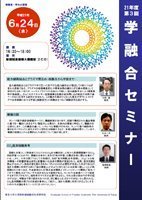AY2009 4th Gakuyugo Seminar
- Date&Time:
- Jul 22, 2009 16:30~18:00
- Venue:
- Large Lecture Room (2C0), New Frontier Science Bldg.

Watching with the phase of X-rays
Associate Professor Atsushi Momose
X-ray fluoroscopic images are usually formed by absorption contrast, which is not applicable to weakly absorbing objects such as polymeric materials and biological soft tissues. X-ray phase contrast, on the other hand, completely removes this limitation. This is because the interaction of the X-ray phase shift with the material is about a thousand times larger than that of the absorption. However, due to the limited choice of photonic devices, the handling of X-rays is not always easy, and the use of X-ray phase has not received much attention for a long time. As a result of our long efforts to develop this field, various applications of X-ray phase imaging have become possible using synchrotron radiation and, more recently, conventional X-ray sources.

Approach from chromosomes to contribute to TR
Associate Professor Hitoshi Sato
In this era, anyone can easily obtain DNA sequence information on a large number of organisms (from humans to new influenza viruses) by accessing the NCBI website. In this seminar, we will discuss how we can contribute to TR by using the analog approach of karyotyping based on cytogenetics, which is a classical method of chromosome analysis. In this seminar, I would like to discuss the contribution of cytogeneticists to translational research by citing specific examples of human-centered research that I have been involved in, and explore the way to future academic integration.

Current Status and Issues of CO2 Geological Storage
Associate Professor Sohei Shimada
CO2 capture and storage, or CCS, has been touted as a way to reduce the amount of CO2 released into the atmosphere. This presentation will focus on geological storage, which is considered to be the most promising method of CO2 storage in terms of quantity, and will discuss the current status of the technology and its challenges.
*The contents of this page were developed based on a machine translation.

